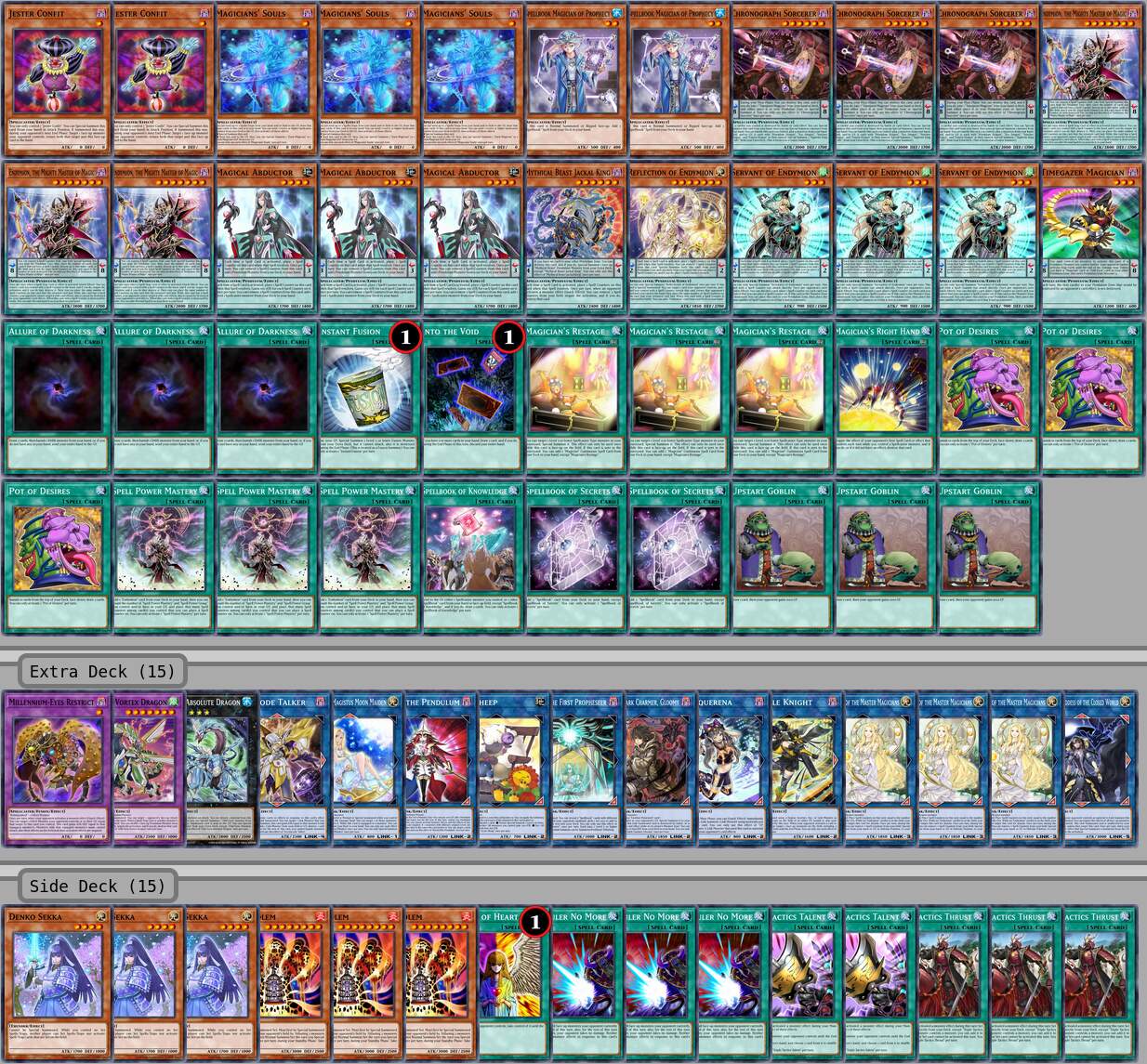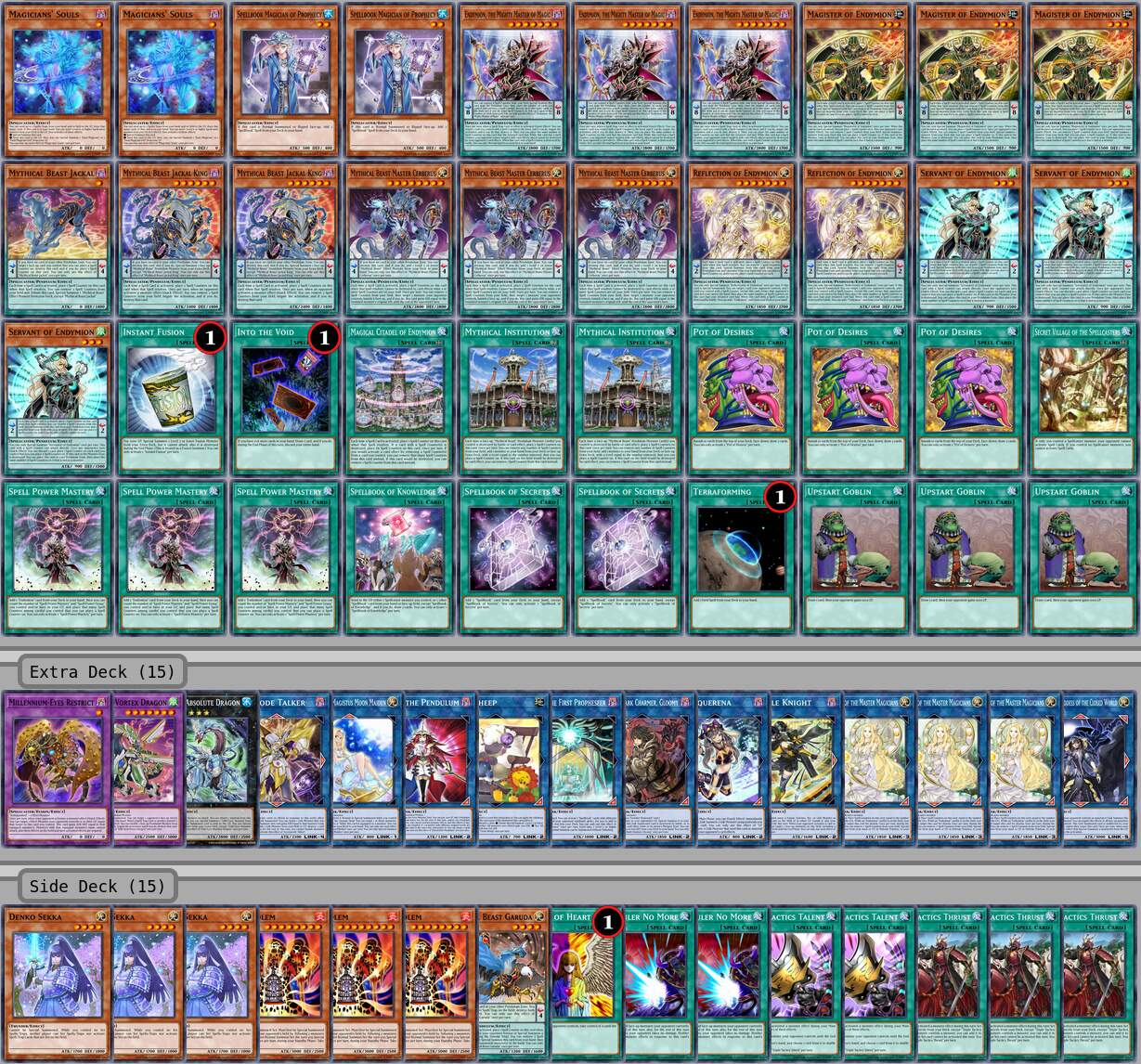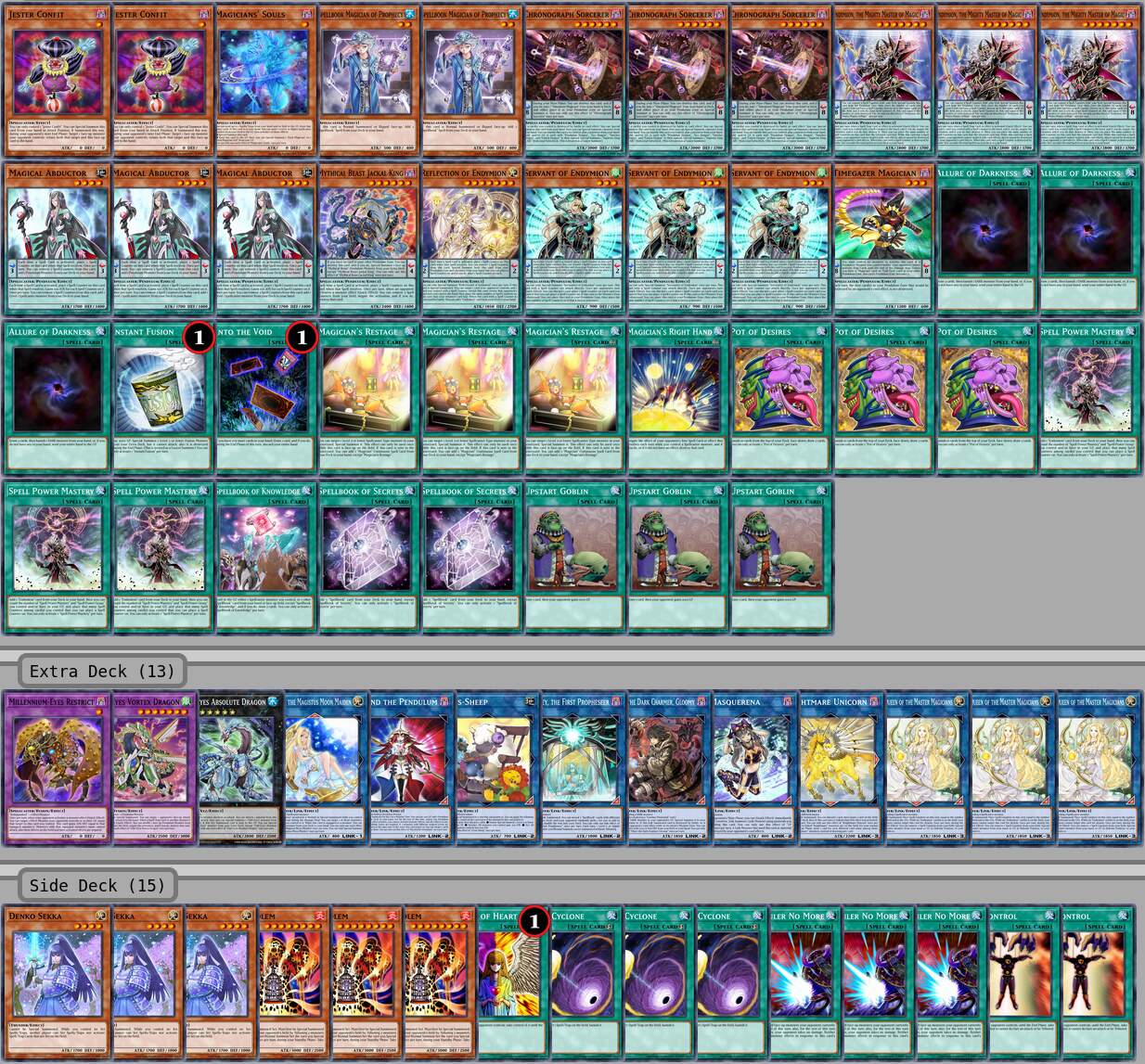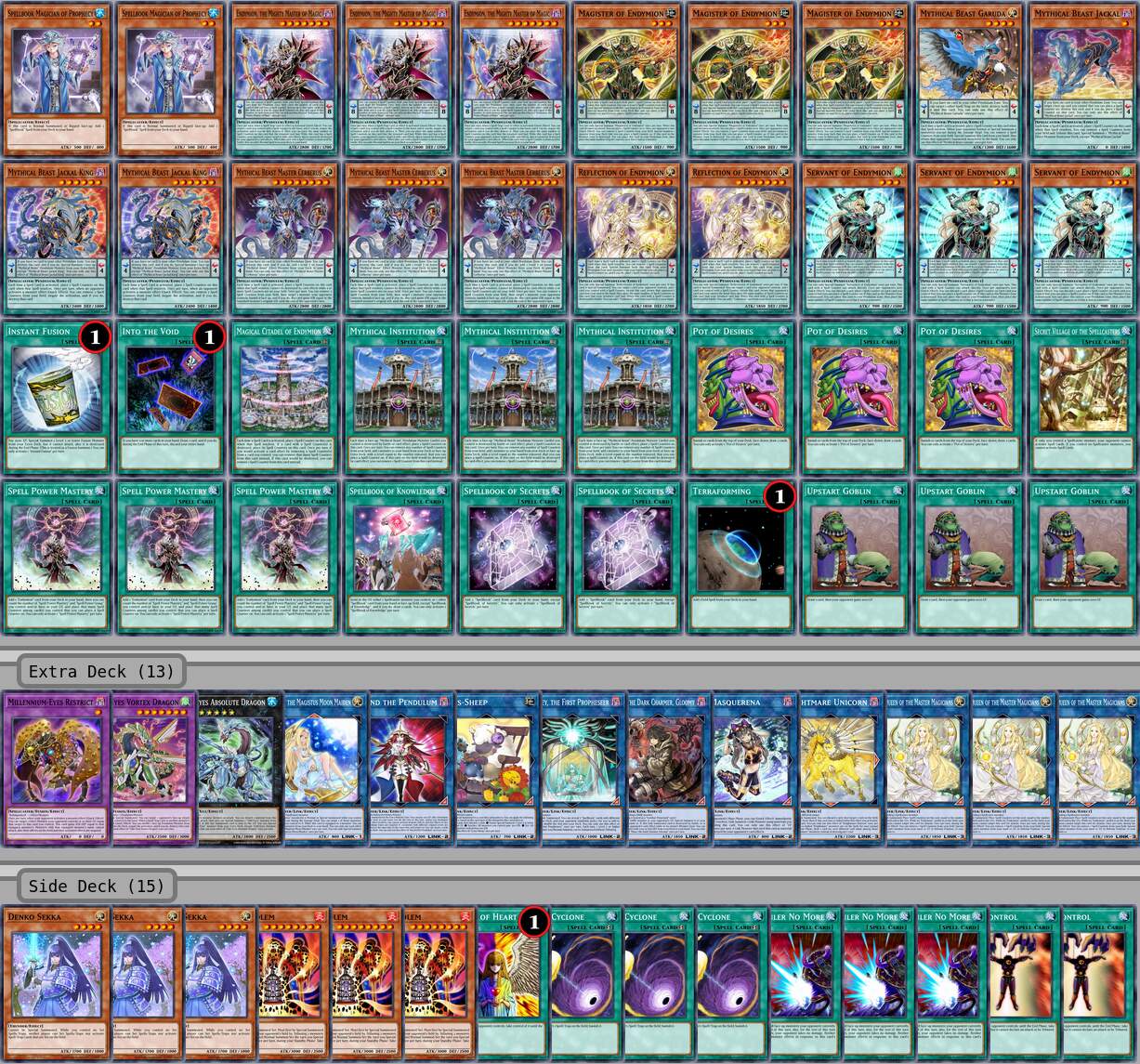Recent changes
- On the January 2024 Banlist, Upstart Goblin was bumped from 1 to 3 and Pot of Desires from 2 to 3 copies!
- On the February 2023 Banlist, Servant of Endymion has finally been unlimited!
Decklists
Please find sample Endymion decklists below. You can click on the images to access an interactive Decklist Viewer!

Draw Endymion
The most common Endymion variant. Uses a slim Pendulum Monster package alongside a bunch of Non-Pendulum Spellcasters, most notably Souls, which serves as extender, searcher, and Draw Engine in one card. Deep draws, revives, and special Summons a lot during the combo. Not very dependent on Pendulum Summons.
Decklists disclaimer
Please keep in mind that the lists above are intended as a baseline for learning the Deck and building experimentation. They are not updated for new formats, so the Side Decks in particular are no more than lists of popular Endymion Sides.
Viability
Representation
Endymion has had no meta-representation since the January 2020 Banlist. February 2023, Servant finally got unlimited after over three years and January 2024, we received more copies of Upstart and Pot of Desires for increased Draw Power. That doesn't change the core problem: Endymion suffers from its incapability to include non-engine cards (like Handtraps or Boardbreakers) and its general inefficiency (especially lack of actual Combos) compared to the other far more resilient modern Combo Decks. All in all, Endymion is a Non-Meta Deck in the TCG.
Outlook
One should not expect Endymion to return to the status of a competitive Deck. This would require Electrumite to be unbanned (unlikely due to TCG sentiment against Pendulum) or active Endymion support (unlikely).
Playstyle
Endymion is a resource-based fragile Combo Deck that can produce unbeatable Endboards, so it prefers to go first.
Going first
Endboard
Going first, it attempts to build a highly
disruptive Endboard on the first turn using Pendulum Summons and the unique mechanic of Spell Counters.
The
Main Deck Negators are Endymion, the Mighty Master of Magic (S/T card
or
effect, SOPT), Mythical Beast Jackal King (monster effect, SOPT), Reflection of Endymion (bounce when SS by Selene), and, in Draw Endymion,
Magician's Right hand (first Spell Card/effect each turn).
The Extra Deck features Odd-Eyes Vortex Dragon (Omni), Selene, Queen of the Master Magicians (SS2 Special Summon from GY/hand),
Apollousa, Bow of the Goddess (monster effects), I:P
Masquerena (SS2 Link Summon), Millennium-Eyes Restrict (equip
to
negate) as disruptions on the opponent's turn.
A typical Endboard consists of Selene in the EMZ, Endymion, Jackal King, Vortex on the field, Reflection
in
the GY, and enough Spell Counters to use the effects of those cards.
Spell Counters are placed by certain Cards in the Deck and allow effects to be activated once a certain number of them is amassed. For instance, a scaled Magical Abductor gains a counter for each Spell activated, and three Counters can be paid to activate its effect to search any Pendulum Monster Card. As a monster, Magical Abductor also gains Counters and can pay three of them to search a Level 1 Spellcaster, for example, Magicians' Souls.
The Combos performed by the Deck are unfixed, instead, a lot of play lines including Draws are executed in parallelism to have the necessary cards in hand/GY and on the field at some point to build the Endboard. Depending on the outcomes of the Draws performed, the steps change, so Combos are relatively unique, but they consist of a few recurring core plays:
Core plays
- The usual Normal Summon is Spellbook Magician of Prophecy ("Blueboy") for one of the lines Prophecy searches Secrets searches Knowledge draws 2 or Secrets search Prophecy Summon Prophecy search Knowledge draw 2. If no Spellbook Card is drawn, then Link-2 Crowley can be Summoned with any two (preferably Special Summoned) Spellcasters to obtain one of the three Spellbook Cards. Alternatively, Abductor can be Normal Summoned for searching Souls, which can Summon itself by sending Reflection/Jackal King (usually) from the Deck to the GY, to eventually Draw up to 2 Cards by recycling Spells.
- A scale that collects Counters is placed early to gain Counters from activated Spells. The best one is Servant, as it can SS from Deck, and the second best is Abductor, as it searches any Pendulum Monster. So if the starting hand contains Servant or Mastery, then (searching then) scaling Servant is almost always the best first action.
- The Pendulum Summon should take place as late as possible after all Draws have been conducted. After the Pendulum Summon, The board is improved by Summoning certain Extra Deck Monsters.
- Summoning Jackal King early and leaving it on the field serves as a protection against many popular Handtraps for the rest of the Combo.
- Selene can be used more than once per turn. Sometimes, all three can be needed in one turn: The first to Special Summon back a Souls, the second to Special Summon back a Jackal King or Endymion or Reflection, the third to Summon Endymion back during the Vortex Combo (described below) and to Summon Reflection on the opponent's turn to bounce one of their cards, or to resummon a used up negate that was bounced by Endymion.
- The Searches and Draws made throughout the Turn serve the purposes of obtaining the cards necessary to build the Endboard and gain Counters on the way. If in doubt when searching or sending with Souls, then the Search/Send should help to enable the Vortex Combo. For instance, if Endymion will be Summoned in any manner this turn, Souls can send Reflection to be revived by Selene later and then overlain with the Summoned Endymion to start the Vortex Combo (the same works if Endymion and Reflection are switched in this scenario). If a successful Vortex Combo is improbable or achievable without the sending off Souls, Souls should send Jackal King instead for an eventual monster negate.
The Vortex Combo is a frequently used line for building Endymion boards efficiently (usually one of the last actions of a turn).
Vortex Combo
The setup is Endymion + Reflection + Blueboy/Souls/Confit, 6+ Spells in field/GY, and it plays out as follows:
- Overlay Endymion and Reflection into Odd-Eyes Absolute Dragon.
- Special Summon Cross-Sheep using your two monsters, triggering Absolute in your GY to Summon Odd-Eyes Vortex Dragon to a zone Cross-Sheep points to.
- Trigger Cross-Sheep to Special Summon your low-level Spellcaster from the GY.
- Link Summon Selene with Sheep + the revived monster, then activate her effect to Special Summon back Endymion.
- On your opponent's turn, activate Selene to Summon back Reflection to trigger her effect and return an opponent's card to the hand.
This isn't the only way to do the Combo - sometimes you already have Magician/Souls in GY, then the other monster can be arbitrary, or you do the combo without Sheep, then you need one additional material, or you have 2 Endymions, etc. Note that to actually use the interruptions enabled by this combo you must have a monster in your face-up ED and cards with Spell Counters to return to the hand, so you have to decide from situation to situation whether you benefit from this combo.
Going second
Going second, the Deck attempts to gain six Spell Counters to resolve Endymion's Pendulum effect that Summons it from a Pendulum Zone and simultaneously destroys as many cards on the field as there are cards that can hold Spell Counters on the field, before building its board to prevent the opponent from recovering on Turn 3. Independently, the Deck can push for a Link-climb into an Access OTK.
The Charmer Links (commonly Dharc or Lyna, depending on the format) come in very handy going second, allowing to make Selene with only two materials invested. Selene in turn usually yields a free Accesscode Talker for 5800 ATK and usually two pops. Beyond the Pendulum can both search a monster and pop two cards, under ideal circumstances.
Deckbuilding
This guide features sample Decklists for orientation. Many of the ratios can be changed to preference and not all cards are strictly required for functionality. Here are a few guidelines to regard when creating new builds:
Deckbuilding guidelines
- You'll want to run not much more than 40 Main Deck cards as your best ones are unsearchable.
- Keep a good ratio of Spells and monsters; aim for a minimum of 15 Spells to ensure enough Counters, optimally 20.
- There is seldom a reason to run any Trap Card in a Deck so centered around Spells.
- Handtraps and sole protection cards are highly detrimental to the Deck's power, as there are almost no low-card combos.
- For the same reason, outside Engines are not recommended, even if they contain Spells (e.g. Invoked), again, because the Deck lives off having the entire hand dedicated to its plays.
- Cards that provide net resource disadvantage - say, Small World, for instance - don't have any legitimacy in Endymion, as they are too costly.
- Situational techs are a bad idea. A card drawn should be useful almost always, be it in the starting hand or mid-combo, independent of specific complementary Draws - if it isn't, that's bricking potential.
- Winmore cards are unnecessary. The Deck already has a great ceiling, an average Endboard often enough to secure a win - reliably getting there through Handtraps and/or unlucky Draws is usually the difficulty, so the worst-case should be taken into account when building, not the best-case.
These guidelines can be summarized by the following principle:
Fundamental Theorem of Endymion
Endymion is a strongly resource-dependent Deck. The general power at any given instance increases exponentially with the availability of its resources. As such, every card included in an Endymion Deck must directly contribute to the Deck's core plays or assist in increasing their consistency.
Side Deck
The Side Deck is a vital part of Endymion Deckbuilding, as the Deck will be forced to go second at least once in a Match. As always, its exact contents should depend on the local Metagame, however, there are notable Sides to be considered at all times:
Popular Side Deck choices
- Denko Sekka and Lava Golem (or Sphere Mode) are powerful and potentially game-winning choices because Endymion is one of the rare Decks that does not at all require a Normal Summon to function. This is a unique advantage to be used.
- Dark Ruler No More is a no-brainer, as it breaks the threat of any monster board, allowing the own board to be built while destroying the opponent's board.
- Triple Tactics Thrust is one of the greatest staples of all time and should be present in every Side Deck. Triple Tactics Talent (notably searchable by Thrust) is basically another copy of Pot of Desires and should be sided in in matchups where its condition can easily be met.
- Cosmic Cyclone is comparatively low-impact, but it deserves a mention because it can out floodgates like Anti-Spell Fragrance that straight-out prevent any plays, thus being a game-changer more often than one might expect.
- Dinowrestler Pankratops, Change of Heart, and Harpie's Feather Duster are mighty one-ofs that can always be considered for a spot.
- Lightning Storm and Evenly Matched are legendary board-breakers, but their synergy with Endymion is not perfect, as you cannot activate Scales while trying to draw into them, which makes the follow-up harder to achieve.
Oversiding
A warning must be made not to overside in Endymion - should you draw into two or three Side Cards, that might be very useful to break the opponent's board, but the three or four remaining cards must also be enough of a resource to build a complete board, which is not always given. So often it is best to only side a few cards, and leave most of the Deck intact, relying on a mixture of the Sides with Endymion's Scale effect - that is never to be undervalued - to break boards.
Draw Endymion
Draw Endymion, also known as the Draw variant, makes heavy use of the Spellcaster Special Summon power and the interaction of Magicians' Souls with Magician's Restage or Selene. Souls, Confit, Chronograph, and Restage allow to reliably Summon Crowley and Selene requiring neither Normal nor Pendulum Summon for that. The high draw power, from which this variant derives its name, digs deeply through the Deck while amassing Spell Counters. The disadvantages of Draw Endymion are direct consequences of its strengths though: With so many non-pendulum monsters around, sometimes scales cannot be completed in this Pendulum Deck. Beyond the Pendulum comes in very handy in these niche situations by fetching a missing scale or Vortex Combo setup piece, but the card is not always safe to use due to voiding all Counters on Scales until a Pendulum Summon is conducted, which is why it's often more of a band-aid for fixing bad hands rather than a regular occurrence.
Magicians' Souls
Souls is a mighty card by itself, drawing, burying, and Summoning all in one. But in conjunction with Restage, it's especially fruitful. Consider a hand containing Souls and Restage: Summon Souls by sending Reflection or Jackal King or Endymion, link it off into Artemis, revive it with restage, send the restage to draw, trigger restage to search Right hand, Link into Crowley to draw 2 more. The utility of this synergy cannot be undervalued; Souls + Restage is the only two-card-combination besides Servant/Citadel + Mastery that achieves so much. Souls + Restage + Restage can even build an entire board by itself (Souls into Artemis revive Souls into Crowley revive Souls send both Restages for draw 2 and Right hand then draw 2 from Spellbooks eventually link into Selene).
Chronograph package
The package of 3x Chronograph Sorcerer + 1x Timegazer Magician is a default inclusion in Draw Endymion, even though Timegazer adds an uncomfortable garnet (you neither want to draw it nor banish it off Desires). The package is still good because it 1. Special Summons a Pendulum Spellcaster (= half a Crowley = half a Beyond) while placing a counter, 2. serves as a high scale (the only other than Endy, which you'd rather Summon than scale going first), and 3. fills your FUED (which is notoriously empty in Draw Endymion at times) allowing more advantage from Pendulum Summons and unlocking Vortex. In case you happen to draw Timegazer alongside Knowledge (your other brick), you can link off Timegazer into Artemis to be sent with Knowledge to draw 2, fixing an otherwise irreparable hand, usually. Timegazer's scale protection effect is very niche but can surprise a non-reading opponent at times going second.
Mythical Endymion
Mythical Endymion, also known as Mythical Beast Endymion, Beast Endymion, Mythical variant, or Beast variant is any version of Endymion that plays a big package of Mythical Beast cards. Most frequently, this means playing 3x Master-Cerberus, 2-3x Jackal King, 0-1x Jackal, 0-1x Bashilisk, and 0-1x Garuda alongside 2-3x Mythical Institution. As a result, the plays are strongly focussed on in-archetype Spell Counter Cards and big Pendulum Summons. The average board is weaker than the average board of Draw Endymion, but as a compensation, the Scales usually remain intact, which allows for strong followups Turn 3 and beyond, including the use of 1-3x Magister of Endymion, which is unreliable in Draw Endymion, but really shines with more in-archetype cards, and can ideally be a +2 alongside serving as an easily searchable high-scale. Mythical Endymion is also more robust going second, as Cerberus can easily run over troublesome monsters and bait negates, and more Spell Counter Cards result in a faster Counter gain for Endymion's Scale effect.
Let's glance over the Beasts:
Mythical Beasts
Cerberus serves as a searcher for the other Beasts, an extender when Summoned by Jackal King, and a potent Boardbreaker by "eating" opponent monsters going second. The up to one copy of "Baby" Jackal is often seen as an alternative searchable Normal Summon, and it can indeed be used as such to Summon Jackal King early going first or Summon Cerberus straight from the Deck going second - but the reason it's frequently included is that this way, Institution can turn any Counter on the field into a low-scale, for desperate situations. Garuda can be a searchable bounce when left in hand going first, or a searchable backrow pop going second. Bashilisk thins the Deck with its Scale effect or recycles a Beast using its monster effect.
If Cerberus is in the starting hand, then it can be scaled, popped to search Jackal King, and Jackal King scaled and popped to Summon that Cerb from the FU-ED. So with one card, a Spellcaster that collects Counters fast was Summoned and the Endboard boss Jackal King searched into the FUED. In case Institution was activated beforehand, it would now have four counters, three of which can be used to search Servant, and continue from there.
In general, Mythical Endymion boasts much more searches than Draw Endymion due to Institution and Cerberus, thus allowing more plannability while increasing the reliance on wise searching decisions.


